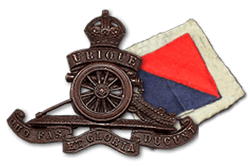72nd (Middlesex) Searchlight Regiment, Royal Artillery
72nd (Middlesex) Searchlight Regiment, Royal Artillery was an air defence unit of Britain's Territorial Army (TA) raised just before the outbreak of World War II, which served as part of Anti-Aircraft Command during and after the war.
| 72nd (Middlesex) Searchlight Regiment, RA 607th (Middlesex) LAA/Searchlight Regiment, RA | |
|---|---|
 Royal Artillery cap badge and AA patch of WWII | |
| Active | 1938–1955 |
| Country | |
| Branch | |
| Type | Searchlight Regiment |
| Role | Air Defence |
| Size | Regiment |
| Garrison/HQ | Heston Twickenham |
| Engagements | Battle of Britain The Blitz |
Origin
As the international situation deteriorated in the late 1930s, the threat of air raids on the UK led to the rapid expansion in numbers of anti-aircraft (AA) units manned by members of the part-time TA. Formed in November 1938, 72nd (Middlesex) was the third of a new group of three TA searchlight regiments raised by the Royal Artillery (previous TA S/L units had all been part of the Royal Engineers and/or converted from infantry battalions).[1] It consisted of HQ and Nos 465–467 Companies (later Batteries) based at a newly built drill hall at Vicarage Road, Heston.[2][3][4] Shortly afterwards, the regiment moved to Twickenham.[3][5][6] It was equipped with the new '90 cm Projector Anti Aircraft', a smaller and lighter piece of equipment than previous searchlights, with a more powerful high current density arc lamp with automatic carbon feed.[1][7]
World War II

Anti-Aircraft Command mobilised in August 1939, ahead of the declaration of war on 3 September, and the regiment took its place in 47th AA Brigade, part of 5th AA Division tasked with defending Southampton.[6][8][9]
Southampton was a regular target for raids by the German Luftwaffe during the Battle of Britain in the summer of 1940, but by November 1940 the regiment had transferred to 40 AA Bde in 2nd AA Division in the Midlands. It had the responsibility for covering RAF airfields in the East Midlands and continued in that role throughout the Blitz of 1940–41.[10][11][12][13]
As the threat from the Luftwaffe waned in 1944, the War Office warned in June that AA Command would have to release manpower to provide reinforcements to 21st Army Group fighting in North West Europe. The run-down began in September 1944, and 72nd S/L Rgt was due to be placed in 'suspended animation' in that month, with its personnel being posted away.[3][5][6][14]
In fact, on 1 January 1945, the regiment was at Hatfield Militia Camp near Doncaster under the command of 32 AA Bde, where it was joined by 80th and 82nd S/L Rgts. All three were reduced to battery strength and consolidated under the command of RHQ 72nd S/L Rgt. The other ranks of 82nd became 466 S/L Bty of 72nd S/L Rgt, while the officers and staff continued as RHQ 82nd S/L Rgt, which became a holding unit at Southampton for surplus (older or unfit) men from S/L regiments that were being converted into RA infantry regiments.[15]
Postwar
When the TA was reconstituted in 1947, 72nd S/L Rgt was reformed at Twickenham as 607 Searchlight Regiment, RA (Middlesex), forming part of 67 AA Bde (the former 41 AA Bde based at Shepherds Bush).[3][16][17][18][19] In 1949, the regiment's role was altered and it was redesignated 607th (Mixed) Light Anti-Aircraft/Searchlight Regiment, RA (Middlesex) ('Mixed' denoting that members of the Women's Royal Army Corps were integrated into the unit).[17][18]
AA Command was disbanded on 10 March 1955, and 607 LAA/SL Regiment was disbanded at the same time.[3][18]
Notes
- Brigstock. Archived March 4, 2016, at the Wayback Machine
- Monthly Army List, January 1939.
- Litchfield, p. 179.
- Osborne, p. 134.
- "72 S/L Rgt at RA 39–35". Archived from the original on 2013-10-22. Retrieved 2015-11-30.
- "5 AA Division 1939 at British Military History" (PDF). Archived from the original (PDF) on 2015-09-23. Retrieved 2015-11-30.
- Routledge, p. 55.
- AA Command 3 September 1939 at Patriot Files.
- Routledge, Table LVIII, p. 376; Table LX, p. 378.
- "2 AA Division 1940 at British Military History" (PDF). Archived from the original (PDF) on 2015-09-23. Retrieved 2015-11-30.
- 2 AA Division at RA 39–35. Archived March 4, 2016, at the Wayback Machine
- Farndale, Annex D, p. 259.
- Routledge, Table LXV, p. 396.
- Routledge, pp. 420–1.
- 82 S/L Rgt War Diary 1945, The National Archives (TNA), Kew, file WO 166/16822.
- Litchfield, Appendix 5, p. 335.
- Farndale, Annex M, p. 340.
- 592–638 Rgts RA at British Army 1945 on.
- 67–106 AA Bdes at British Army 1945 on. Archived 2016-03-04 at the Wayback Machine
References
- Gen Sir Martin Farndale, History of the Royal Regiment of Artillery: The Years of Defeat: Europe and North Africa, 1939–1941, Woolwich: Royal Artillery Institution, 1988/London: Brasseys, 1996, ISBN 1-85753-080-2.
- Norman E.H. Litchfield, The Territorial Artillery 1908–1988 (Their Lineage, Uniforms and Badges), Nottingham: Sherwood Press, 1992, ISBN 0-9508205-2-0.
- Mike Osborne, 20th Century Defences in Britain: The London Area, Market Deeping: Concrete Publications, 2006, ISBN 0-9540378-2-0.
- Brig N.W. Routledge, History of the Royal Regiment of Artillery: Anti-Aircraft Artillery 1914–55, London: Royal Artillery Institution/Brassey's, 1994, ISBN 1-85753-099-3